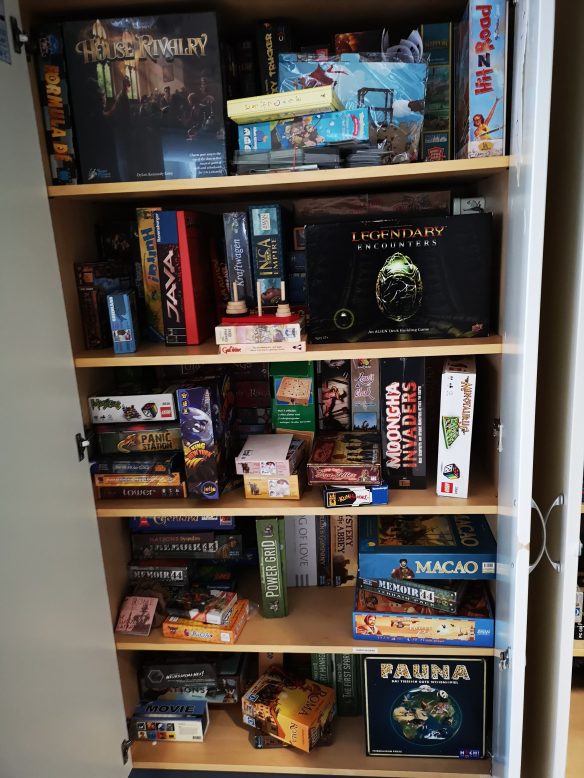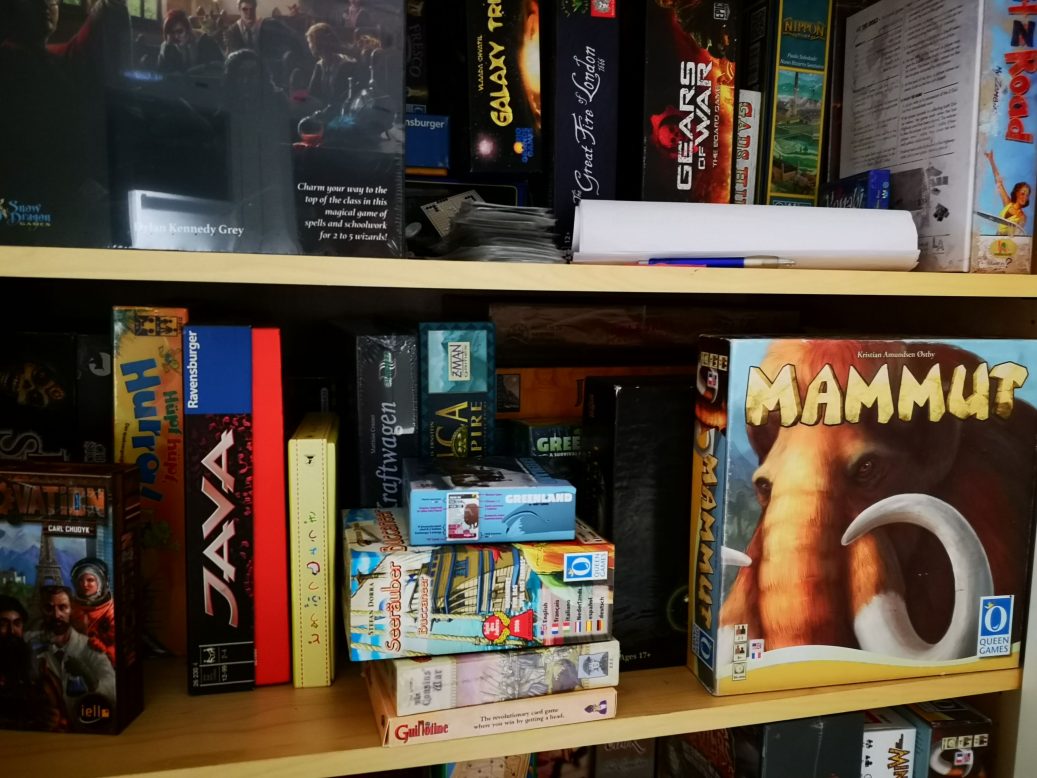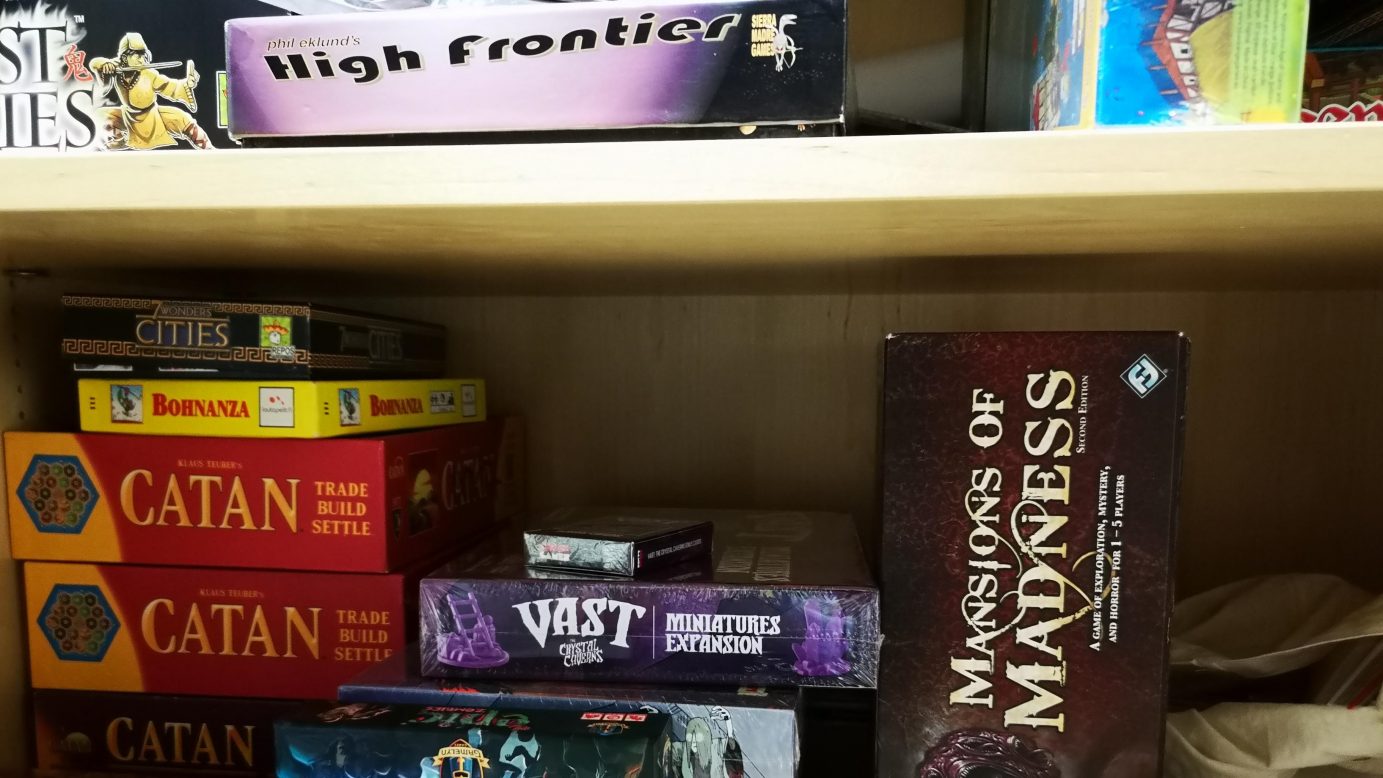Back when I was young I had two answers to the question ‘what do you want to be when you grow up?’. The first was ‘a librarian, ook’. The second was ‘a fire engine’. Neither in the end turned out to be the path my life took, but I’ve spent a fair bit of this month exploring what it would have been like if things had been different. I’ve been dressing up in bright red and speeding up to fires in progress. Also, I’ve been delving into the game collection at work, and reorganising it so that it’s an easier thing for the division to work with. It’s part reference library, part circulating collection, and part teaching material for the curriculum. And previously it’s had neither a catalogue or a booking system other than signing a name to a sheet of paper.
The great thing about being a games academic, rather than an academic that’s interested in games, is that nobody blinks an eye about you obsessing about games during the workday. It is, after all, your job. Also, yeah… we have a game collection at work, and it’s awesome. Not a lot of my games in it, yet, but that will change. I’m gradually ejecting things from my home collection and adding them to the common library. Not that there’s much room to do that… the IxD collection is comprehensive. And a collection this size, with this intention, deserves proper curation. It needs to be usable. Or, in other words, it has a particular requirement for organisational accessibility.

I took this picture, and some others, during my interview for the job. There are three other cupboards like this.
I’m not telling you this to brag about my new job, although holy shit have you seen what my new job is. I’m telling you this because for some of you there might be an interesting overlap between what I’ve been doing and what you need to do in the future. And maybe I can lighten that load a little because, as someone with a background in software engineering, I have written up a very straightforward (and rudimentary) collection management system that might be of interest. Today I want to tell you about it.

This too
The game collection in the IxD department sprawls over four sizable cupboards and numbers over 400 games. These include predictable classics like Go. They also include straight up nerd-porn like a vintage copy of Space Hulk. In amongst the boxes there are multiples (ten copies of Catan, because it was used to teach a course) and a healthy number of expansions. As you’d expect from a game collection of this nature, not all the games are in pristine condition and some copies are missing pieces. Games can be loaned out to students, temporarily borrowed out within the division itself, and taken home by staff provided the division, as a whole, knows where they’ve gone. This has been the booking system for a while…

The intention behind the cupboards is that the games are alphabetically sorted, at least within reason, but that’s sort of lost integrity over the years. When people return games it’s often a case of ‘it sits where it fits’, and there isn’t a lot of slack there. The cupboards are literally overflowing and there’s no real scope for adding more shelving units. The obvious riposte to the statement ‘We don’t have enough room to store all the games’ is ‘Well, get rid of some games’. Whether that happens or not is up for debate, but not everything in the cupboards is a treasure. That has to be balanced against the fact that some of the games in there are proper collectible gems. It’s not really that this is a ‘University Collection’ but rather it’s a collection that belongs, in various subsets, to different people and departments. As such, it’s not really possible to tell what games can be removed, what should be removed, and where they should go to if they are. That’s a topic for a later day, but we’ve already addressed some of the reasons you might use to cull a game from a collection.
So, when I’ve had a spare half hour or so over the past month I’ve been spending it reorganising the shelves. In this I’ve been ably assisted by several colleagues, but since I’m the fool that started the project it falls on my shoulders to see it through to the end. I can’t just say ‘Nah, I’m bored’ and give up. I’ve started so I’ll finish. There’s some talk of going through and sleeving the especially high-demand games but that, I suspect, is a project that will be done without my involvement.
There’s more to it though than just alphabeticising and prettying up the shelves. I’ve also written up a collection management system and it’s here that some of you might be especially interested.
It works like this:
- You record your collection in BGG
- The MLU BGG API has been expanded to include support for ‘managed collections’.
- It reads in all your games
- Populates a ‘collection copy’ entry for each box
- Creates a ‘collection booking’ entry for each game so you can track who has it
- Creates a QR code for each copy of each game
- Generates the actual printable QR codes
- The MLU WordPress plugin has been expanded (in our local testing version) to create a catalogue of games with images and BGG data (and, of course, MLU accessibility teardowns where available).
- A (currently very slipshod) app then reads in the QR codes and toggles a game from being ‘available’ to being booked out, with the details of who booked it out and to who. It tracks dates, and creates a database entry that lets you see the history of the game’s bookings.
Hidden in there is the real task of the past few weeks – attaching QR codes to all the games we have in the collection.
We’ve settled for attaching the codes, using scotch tape, to the inside lids of the boxes. Scotch tape actually comes off pretty easily which means damage is minimised in all cases and eliminated in many. But let me tell you – matching over 400 QR codes to games scattered around dozens of shelves, then attaching them… is a chore. I’m not quite at the point where I’m ready to throw a match into the cupboards and call the job done, but…

I probably won’t because the vast bulk of the job has already been accomplished.
The image above is of the cupboards almost done. Or rather, the first pass is almost done. Cataloguing the collection by itself was a job that took a few hours, and it wasn’t done perfectly. Some games got missed, or double registered, and as such there’s a bit of tidying up that ‘s brought it more into alignment with reality. And, as soon as people got wind that the collection was being organised a whole pile of games got returned into the cupboards mid-reshuffling. So the first pass has managed to get things coded, in roughly alphabetical order, and then a second pass will be needed to reorder things into their approximate final order.
One thing that’s been a surprise to me is how much of a surprise the cupboards are to others. People that have been working at the university for months had no idea that they contained games. A few people have stopped by to take photos. Others remark in wonder that this Alladin’s Cave of Play was mere metres away from them the whole time. To maximise space in the cupboards, and also to aid in discoverability of the existence of the collection, we’ve put a number of the bigger and more visually striking boxes face up on top. They’ll eventually be chosen so that the selection above matches the alphabetical ordering underneath. You’ll find Cthulhu Wars above the C cupboard, and Gloomhaven above the G. That doesn’t look great at the moment, but I think it’ll eventually look cracker, as the Derry Girls might say.
It’s actually surprisingly relaxing to do all this. I’ve often remarked that shelving a game collection is like a game of Tetris (and indeed I have a skeleton idea on that theme), and it’s especially fun to do it with a set like this that contains surprises on every shelf.
At the time of writing there’s only one shelf left to do – letters W through to Z. And then there are the boxes that I put aside to deal with later. This has taken a lot of time but when it’s done we’ll have something pretty useful – a fully catalogued system that anyone with a mobile app will be able to work with. For the first time, the game collection is available online along with a real-time view of how many games are actually in the cupboards.
It’s the software that manages this though that’s the main thing, and when I idly mentioned on Twitter that I had put something together there was a murmur of interest…
See, I’m not just writing this software for our divisional game collection. I have my eyes on a bigger prize – those of you receiving the Gaming in Gothenburg monthly post will know of the research bid on which I’ve been working and this software is related to that. The plan is for this to be a low-cost, low-complexity way for an organisation to handle a circulating board game collection without having to invest in anything like library management software or bespoke solutions. I intend this to be something that anyone with a BGG collection can potentially use.

Our WordPress plugin already lets people output their collection to their site. We have our own personal collection publicly available here. But this is a different kind of collection, and that’s an important distinction. What we have here is the difference between listing a collection and supporting a library. Eventually I plan to let people style and access their catalogues without needing to go through WordPress, but one step at a time. But the key thing here is data – the catalogue view is much heavier than the collection view, but it’s also far more comprehensive and offers opportunities for it to be more so as the use-cases arise.
I’m in a few library focused facebook groups, because as I’ve written before I think libraries have an incredibly important role in reducing inaccessibility and addressing social issues through board games. And what I commonly see is requests for guidance on how best to organise and run a public collection. There’s currently no integration provided in the software I’ve written for working with a Library Management System, but this is still early days. I think though there are lots of places that might benefit from it as it stands… or rather as it will stand with a bit more polishing and at least some concern given to security.
Are you running a game café? Or perhaps a game collection at a convention? Wouldn’t it be pretty nifty if you could handle the bulk of the work by just downloading an app and entering your collection into BGG? I was at one point a couple of years ago in discussion with the organizers of Tabletop Scotland about a system like this, but the support available for the project at RGU fell away. Now though, here the software is…
What about if you just have a meaty collection of your own and like to lend it out to people? Instead of using some weird mishmash of tools and techniques you could just leverage your already existing BGG collection with minimal effort. Click a link and it’ll tell you exactly who has what games, for how long, and who loaned it out. Press another button and it could even generate stats. ‘Ten people have borrowed my copy of Terraforming Mars, but nobody has ever borrowed Hanabi because why would they Hanabi is horrible’. I’m up for adding import tools, export tools… hell, even ecommerce integration if it seems like it could work for online shopping or stock management.
(As another aside, the departmental collection has Hanabi deluxe edition and it’s such a pretty box that I might even be willing to play it)
However, the downside of this is that it’s not something I can really support for free. For the needs of our IxD department and my future research plans I can host it all off my server without too much trouble. I can manage capacity there because I know exactly how many collections, of how many games, are going to be involved. I’m with Siteground (affiliate link) and they are excellent but they give you what you pay for rather than what you think you’re paying for. Specifically, you don’t get unlimited resources or server space because that’s a massively false economy. I’m fixed at 30 GB which is… fine, but does put a ceiling on what I can do given that this storage has to handle all the databases I run, all the sites I support (including but not limited to Meeple Like Us) and email. I also have a particular slice of the server I get, and a particular quota of bandwidth. So, I’m not keen to make this available too generally because I can’t control capacity that way.
But the system currently works through an API key, and having one of those permits access to the whole kit and caboodle. And that means that I can selectively give access and control what that access means. That’s important, because it also means I can do some load balancing between different categories of API key. If I was going to open this software up to everyone, I’d need to pay for another server, and then potentially more if the demand ever reached that point.
So, this is why I’m telling you this – whether this particular software becomes available to the wider public depends on whether or not the wider public would be willing to pay for it. I’m writing it for my future and current use-cases, but anything else would be a scope increase that I’m willing to address but it needs to be funded.

I’m not talking ‘pay my salary’ money here. I’m talking ‘Pay my costs and the time I’d need in order to add the management and expansion of the system to my todo list’. I’m perfectly happy with this meeting my needs and going no further, but you know… there’s perhaps an opportunity here for all of us.
If you’re interested then, please email me at michael@meeplelikeus.co.uk and let me know. More, let me know what you’d want a system like this to be able to do and what kind of value you think that system would have in terms of either a one-off cost or on an ongoing basis. I’m thinking that, whatever happens, some personal collection access to this will be available as a free reward for Patrons at the $5 level and above, but that’s (again, for capacity issues) going to have to come with limitations. If you weren’t a patron does that seem like a reasonable monthly sum to manage your circulating gaming collection? Too low? Too high? What if there were reduced costs for public bodies, charities, and educational establishments. What is it worth, if anything, to you?
Other features like library management system integration, export tools, import tools, ecommerce settings, and so on – those would all be dependant on the interest and likely cost to impact ratio. I don’t need any of these things to accomplish my goals, so it all depends on whether it’s worth the time and effort based on the interest of others.
So, if you like the sound of this system and would like to convince me to make it available, please drop me an email! If there’s enough interest, I’ll let you know. If not, well… you can just enjoy the pictures of the game collection I’ve been curating at work!
